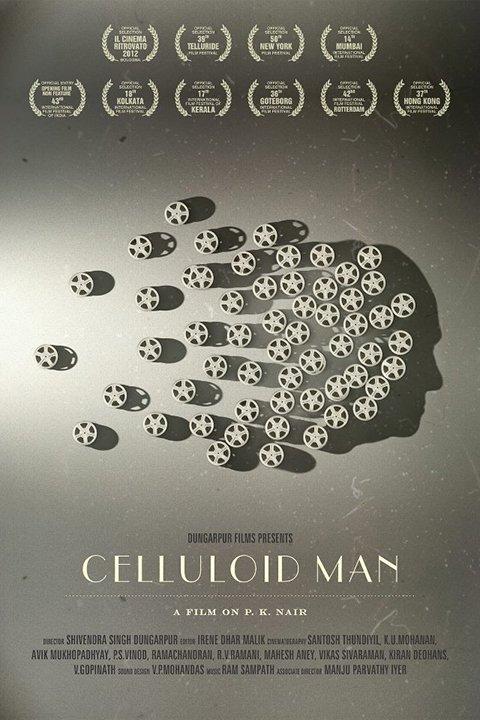
🪶 Story & Synopsis
In the 2012 documentary film “Celluloid Man,” directed by Shivendra Singh Dungarpur, the audience is taken on a captivating journey through the life and work of the legendary Indian archivist P. K. Nair. Nair, the former curator of the Indian National Film Archives, is portrayed as a passionate and dedicated individual who has devoted his entire life to preserving the cultural heritage of Indian and World Cinema.
The film showcases Nair’s remarkable journey from his significant yet often unappreciated role as a film archivist to his well-deserved recognition as a living encyclopedia of cinema. Despite the lack of limelight in his profession, Nair’s unwavering commitment to preserving the history of cinema shines through in the documentary.
Shivendra Singh Dungarpur skillfully brings to light the sacrifices Nair made in his personal ambitions to become a filmmaker, instead choosing to work tirelessly in the shadows of a theater, safeguarding the legacy of Indian cinema. The film beautifully captures Nair’s deep connection with his Archive, built over the years, and his relentless efforts to save the often overlooked treasures of our country’s cinematic history.
Nair’s dedication to his craft is portrayed as nothing short of heroic, as he single-handedly works to ensure that the legacy of Indian cinema is preserved for future generations. The documentary paints a poignant picture of Nair’s life, portraying him as the unsung hero of Indian cinema, deserving of recognition and gratitude for his invaluable contributions.
Through a lens of admiration and respect, “Celluloid Man” pays homage to P. K. Nair’s extraordinary passion for movies and his lifelong commitment to the art of filmmaking. It is a compelling narrative that delves deep into the heart of cinema and the unsung heroes who work tirelessly behind the scenes to ensure that its legacy endures.
🧑 Cast & Crew
P.K. Nair
| Actor | Role |
|---|---|
| U.R. Ananthamurthy | Actor |
| Beena Antony | Actor |
| Shabana Azmi | Actor |
| Ramachandra Babu | Actor |
| Jaya Bhaduri | Actor |
💬 Reviews and feedback
Ever wondered what it would be like to meet the guardian angel of movies, the ultimate superhero of celluloid? Well, grab your popcorn and let’s dive into the world of “Celluloid Man”, a documentary that chronicles the incredible journey of P.K. Nair, an archivist known for his unwavering dedication to preserving Indian cinema. Think of him as Indiana Jones, but instead of hunting for ancient artifacts in dusty tombs, he’s rescuing precious film reels from oblivion. ✨
Celluloid Man, directed by Shivendra Singh Dungarpur, is a heartfelt tribute to Nair’s extensive work and passion. The documentary spans over 150 minutes and takes you on a tour through decades of cinematic history, making sure you understand just how monumental Nair’s contributions were.
The Plot:
The storyline isn’t so much about plot twists or cliffhangers; it’s more about capturing the essence of Nair’s life mission. We see glimpses of his early years in Trivandrum, his time spent in Mumbai film studios, and finally his establishment as the founder of the National Film Archive of India (NFAI). The narrative covers numerous filmmakers and spans multiple decades, making it a comprehensive homage to both Nair and Indian cinema.
Themes and Tone:
If you think a documentary about film preservation sounds like watching paint dry, think again! The tone is reverential but never boring; it crackles with life and enthusiasm. It masterfully blends historical context with personal anecdotes from Nair himself and other industry stalwarts who have been impacted by his work.
Acting and Characters:
- P.K. Nair: The man himself is the heart and soul of this documentary. His passion for films is infectious; you can almost see his eyes light up whenever he talks about them.
- Supporting Voices: Various filmmakers, critics, and actors contribute their stories and perspectives on how Nair’s work influenced them personally. These testimonials add depth to our understanding of his impact.
Direction:
Dungarpur does an exceptional job at weaving together interviews, archival footage, and personal stories into a cohesive whole. The pacing might feel leisurely at times—some might even say it’s a tad too long—but this length allows for an immersive experience that brings out every nuance in Nair’s journey.
Score:
The background score complements the nostalgic tone perfectly without overwhelming the narrative. It sets just the right mood for each segment—whether it’s recounting joyful discoveries or lamenting lost films.
Cinematography:
The visuals are nothing short of poetic. From capturing old film reels to showcasing bustling Mumbai streets where much cinematic magic happens—the cinematography enhances the storytelling beautifully.
Production Design & Special Effects:
This isn’t your typical blockbuster with CGI explosions or intricate set designs. However, its charm lies in its authentic portrayal using real locations—film archives filled with rows upon rows of celluloid treasures are sights to behold!
Editing & Pace:
The editing seamlessly stitches together various timelines while maintaining viewer interest throughout most parts despite its lengthy runtime. However—and here comes my tiny gripe—some segments could have benefited from tighter editing to avoid feeling slightly sluggish.
Binge-Watching Tips:
- Break It Down: Given its length (150 minutes), consider watching it in two sittings if you’re not up for a marathon session.
- Mood Lighting: Dim those lights! It enhances focus on screen details reminiscently akin to watching classics in an old theater setting!
- P.S.: Research Recommended!
If you’re not familiar with Indian cinema history beforehand—a quick Google search wouldn’t hurt! Knowing key names/events will enrich your viewing experience immensely!
Interactive Elements – Let’s Chat!
If “Celluloid Man” has piqued your interest (or even if it hasn’t!), I’d love to hear what documentaries you enjoy that delve deep into niche subjects or unsung heroes? Maybe you’ve got recommendations that also blend history seamlessly with personal journeys?
Are there other ‘guardians’ within any field whose efforts often go unnoticed yet deserve recognition? Sound off below—we might stumble upon hidden gems worth celebrating together!
A Final Reel – Conclusion & Rating:
As we wrap up our cinematic journey through “Celluloid Man,” it’s clear this labor-of-love documentary serves as much more than just educational viewing—it stands testament towards immortalizing legacies often overlooked yet profoundly impactful.
Despite minor pacing quibbles—it remains enthralling throughout inspiring us audience members alike regarding not only value preservation but importance cherishing heritage altogether.
So whether cinephile seeking deeper understanding evolution India’s rich tapestry filmmaking—or simply someone captivated extraordinary true-life tales resonating universally—do yourself favor give “Celluloid Man” shot!
Rating: ⭐(4/5) /10
Lights down… curtains fall… until next screening adventure awaits us all again soon enough! ️
| Pros | Cons |
|---|---|
| Comprehensive coverage of P.K. Nair’s extraordinary life journey | Feels a trifle long due to covering many decades and filmmakers |
| Excellent homage to Mr. P.K. Nair | Length of the movie might be a drawback for some viewers |
| Enthralling and educational portrait of a remarkable man | Some viewers may find it insufferably boring due to the length |
| Captures film history with life and enthusiasm | May sound dry to viewers not interested in film history |
Feedback
-
Celluloid Man (2012) - IMDb
Thoughtfully directed by Shivendra Singh Dungarpur, CELLULOID MAN is a documentary on the former curator of the Indian National Film Archives, who still is well connected with his Archive built over the years, after getting retired from his hugely significant but thankless job. The passionate man needs to be saluted for his notable efforts made to save the ‘not so recognized’ cultural heritage of our country, just single handedly. He is a living encyclopedia of both Indian and World Cinema, who has simply devoted his complete life to the passion for movies, sacrificing his own will to become a film-maker in the process. And that’s indeed a bold step to take, working in the dark ambiance of a theater instead of sharing the shining limelight of the tinsel world.
-
Celluloid Man | Rotten Tomatoes
Celluloid ManCritics ReviewsAudience ReviewsCast & Crew
Shivendra Singh DungarpurDirectorU.R. AnanthamurthyActorBeena AntonyActorShabana AzmiActorRamachandra BabuActorJaya BhaduriActor
PhotosCelluloid ManMovie Info
- Director
- Shivendra Singh Dungarpur
- Producer
- Shivendra Singh Dungarpur
- Genre
- Documentary
- Original Language
- English
- Release Date (Streaming)
- Apr 5, 2017
- Runtime
- 2h 44m
-
Celluloid Man streaming: where to watch online? - JustWatch
Watch Now
FiltersStreaming in:Something wrong? Let us know!FiltersStreaming in:Something wrong? Let us know!Currently you are able to watch “Celluloid Man” streaming on Criterion Channel.The JustWatch Daily Streaming Charts are calculated by user activity within the last 24 hours. This includes clicking on a streaming offer, adding a title to a watchlist, and marking a title as ‘seen’. This includes data from ~1.3 million movie & TV show fans per day.
Rank Title 23223.
No Stone Unturned
New
23224.
Rebirth
New
-
Celluloid Man (2012) Stream and Watch Online | Moviefone
Watch ‘Celluloid Man’ Online’Celluloid Man’ Release Dates
Watch in Movie Theaterson September 1st, 2012
⚠️ Explanation (Spoiler)
In “Celluloid Man”, the narrative follows a familiar path with the plot elements and character interactions telegraphing their outcomes well in advance. The tension between Hyung-do and his manager sets the stage for their inevitable conflict, while Hyung-do’s blossoming romance with Su-yeon unfolds alongside the company’s pursuit of him. The film’s melodramatic tendencies and Korean cinema clichés make the storyline quite predictable, leaving little room for surprise.
The subdued love story between Hyung-do and Su-yeon lacks the emotional depth needed to truly resonate with the audience. While actors So Ji-sub and Lee Mi-yeon share moments of chemistry, the narrative fails to capitalize on their potential, resulting in a storyline that feels formulaic and uninspired. The subplot involving the police, initially prominent, abruptly disappears only to resurface later with flimsy justification, disrupting the narrative flow.
Despite its shortcomings in storytelling, “Celluloid Man” shines in its expertly choreographed action sequences, offering viewers a thrilling visual experience. Director Lim Sang-yoon’s attempt to critique company hierarchy, work ethics, and loyalty adds depth to the film but falls short of delivering a truly impactful message.
For viewers seeking a straightforward thriller with impressive action scenes and a familiar storyline, “Celluloid Man” may prove entertaining. However, those looking for a more intellectually stimulating narrative may find the film lacking in depth and originality. While the film has its moments, particularly in its action sequences, its overall predictability hinders its potential to be truly memorable.
The DVD edition of “Celluloid Man” features a high-quality transfer with excellent image and sound quality. English subtitles are provided for the main feature, but are not available for the bonus features. The DVD extras include a journal, personnel records, action journal, poster photo shoot, premiere footage, stills gallery, and a trailer, offering fans a deeper look into the film’s production.
👪 Parents Guide & Age Rating
TV-PG
Age Rating:
This documentary film, Celluloid Man (2012), is suitable for viewers of all ages.
Parental Guide:
Celluloid Man is a documentary that celebrates the life and work of Mr. P.K. Nair, a prominent figure in Indian cinema history. The film focuses on his dedication to archiving films in India and his significant contribution to preserving the country’s cinematic heritage.
Sex & Nudity:
The film contains no sexual content or nudity.
Violence & Gore:
There is no violence or gore depicted in the documentary.
Profanity:
There is no use of profanity in the film.
Alcohol, Drugs & Smoking:
There are no scenes depicting alcohol, drugs, or smoking.
Frightening & Intense Scenes:
There are no frightening or intense scenes in the documentary.
Overall, Celluloid Man is a heartfelt tribute to a cinema enthusiast and is highly recommended for audiences of all ages who appreciate the art of filmmaking and the preservation of cinematic history.
📺 Streaming and where to watch
| streaming service | extra information |
|---|---|
| Criterion Channel | Currently you are able to watch ‘Celluloid Man’ streaming on Criterion Channel. |
❝ Quotes and Cult
Celluloid will be the next decade's black and white.
As a career, the business of an orthodox preacher is about as successful as that of a celluloid dog chasing an asbestos cat through hell.
🤖Celluloid Man Reddit Talks
Is celluloid better than digital?
There is a debate among film enthusiasts about whether celluloid film is better than digital. Some people believe that celluloid film is far better at immersing the viewer into the story. They argue that celluloid film has a more organic and natural look that digital film cannot replicate. Others believe that digital film is superior to celluloid film because it is more versatile and can be used to create a wider range of effects.
One of the main arguments in favor of celluloid film is that it has a more immersive and engaging viewing experience. Celluloid film has a unique grain structure that gives it a warm and inviting look. This grain structure helps to create a sense of depth and realism that is often lacking in digital film. Additionally, celluloid film has a wider color gamut than digital film, which means that it can produce more vibrant and lifelike colors.
However, digital film has several advantages over celluloid film. Digital film is more versatile and can be used to create a wider range of effects. For example, digital film can be used to create slow-motion and fast-motion effects, as well as other special effects that would be difficult or impossible to create with celluloid film. Additionally, digital film is more durable than celluloid film and is less likely to be damaged or scratched.
Ultimately, the decision of whether celluloid film is better than digital film is a matter of personal preference. There are valid arguments to be made for both sides of the debate. However, it is important to note that celluloid film is a dying art form. As more and more filmmakers switch to digital, it is becoming increasingly difficult to find celluloid film projectors and theaters that can show celluloid films.
Found footage in movies
Found footage is a cinematic technique in which all or a substantial part of the work is presented as if it were film or video recordings recorded by characters in the story, and later “found” and presented to the audience. Found footage films often use shaky camera work, jump cuts, and other techniques to create a sense of realism and immediacy.
Found footage films have been used to tell a wide variety of stories, from horror to comedy to documentary. Some of the most famous found footage films include “The Blair Witch Project,” “Paranormal Activity,” and “Cloverfield.” These films have all been successful in creating a sense of realism and suspense that is often lacking in traditional narrative films.
However, found footage films can also be criticized for being repetitive and formulaic. Some critics argue that found footage films rely too heavily on jump scares and other cheap tricks to create suspense. Additionally, found footage films can be difficult to follow, as the shaky camera work and jump cuts can make it difficult to see what is happening on screen.
Despite these criticisms, found footage films continue to be popular with audiences. Found footage films offer a unique and immersive viewing experience that can be both thrilling and terrifying. As long as filmmakers continue to find new and innovative ways to use the found footage technique, found footage films will continue to be a popular genre.
Why New Yorkers Still Love Celluloid Film
New York City is home to some of the most iconic movie theaters in the world. These theaters have been showing celluloid films for decades, and they continue to do so despite the rise of digital projection. There are several reasons why New Yorkers still love celluloid film.
First, celluloid film has a unique look and feel that digital film cannot replicate. Celluloid film has a warm and inviting look that many people find more immersive and engaging than digital film. Additionally, celluloid film has a wider color gamut than digital film, which means that it can produce more vibrant and lifelike colors.
Second, celluloid film is more durable than digital film. Celluloid film is not as susceptible to damage or scratches as digital film. This makes it ideal for long-term storage and preservation.
Third, celluloid film is a part of New York City’s history. Many of the city’s most iconic movie theaters were built during the golden age of Hollywood, and they have been showing celluloid films ever since. For many New Yorkers, celluloid film is synonymous with the movie-going experience.
Of course, there are also some disadvantages to celluloid film. Celluloid film is more expensive than digital film, and it is more difficult to project. Additionally, celluloid film is flammable, which can be a safety hazard.
Despite these disadvantages, celluloid film remains popular in New York City. New Yorkers love the unique look and feel of celluloid film, and they appreciate its durability and historical significance.
Does the type of film (celluloid 35/70mm vs digital) have any impact on the quality of the movie?
There is a debate among film enthusiasts about whether the type of film used to shoot a movie has an impact on the quality of the movie. Some people believe that celluloid film produces a superior image to digital film, while others believe that digital film is just as good as celluloid film, if not better.
There are several factors that can affect the quality of a movie, including the type of camera used, the lighting, and the editing. However, the type of film used can also play a role. Celluloid film has a unique grain structure that gives it a warm and inviting look. Digital film does not have this grain structure, and some people believe that this makes digital film look less natural and realistic.
Additionally, celluloid film has a wider color gamut than digital film. This means that celluloid film can produce more vibrant and lifelike colors. Digital film has a narrower color gamut, which can result in colors that look less saturated and less realistic.
However, digital film has several advantages over celluloid film. Digital film is more versatile and can be used to create a wider range of effects. For example, digital film can be used to create slow-motion and fast-motion effects, as well as other special effects that would be difficult or impossible to create with celluloid film.
Additionally, digital film is more durable than celluloid film and is less likely to be damaged or scratched. This makes it ideal for long-term storage and preservation.
Ultimately, the decision of whether to use celluloid film or digital film is a creative one. There are valid arguments to be made for both sides of the debate. However, it is important to note that celluloid film is a dying art form. As more and more filmmakers switch to digital, it is becoming increasingly difficult to find celluloid film projectors and theaters that can show celluloid films.
Top discussions
- https://www.reddit.com/r/cinematography/comments/h909fh/anyone_else_surprised_by_how_good_a_film_looks/
- https://www.reddit.com/r/movies/comments/xly1jc/why_new_yorkers_still_love_celluloid_film_great/
- https://www.reddit.com/r/tollywood/comments/ynbdgc/a_scene_from_maniratnams_celluloid_bombay1995_it/
- https://www.reddit.com/r/movies/comments/ry5p16/does_the_type_of_film_celluloid_3570mm_vs_digital/
- https://www.reddit.com/r/cinematography/comments/1b7v27h/stills_from_my_latest_film_nocturnal_celluloid/
❓ Frequently Asked Questions
Who is known as the celluloid man?
Nair, the celluloid man, is the ‘militantly eclectic’ film preservationist who saved thousands of films, not just for India but for the whole world.
What is the meaning of celluloid film?
Celluloid is a type of plastic that’s transparent and flammable, traditionally used for shooting movies. It stands for movies in general due to its association with filmmaking.
When did they stop using celluloid film?
Celluloid film was standard for theatrical productions until around 1950. However, for amateur use like 16mm and 8mm film, they transitioned to acetate “safety base”.
What is the celluloid movie?
Celluloid film was popularly used for motion pictures from the 1880s to the 1950s. It is a transparent thermoplastic providing a sturdier and more durable option than early filmmaking materials.
Do they still use celluloid film?
In the past, all productions were shot on celluloid film. However, currently, nearly everything we watch is captured digitally, marking a shift away from celluloid film usage.
🔀 Recommended Movie and TV Show
- Electric Boogaloo: The Wild, Untold Story of Cannon Films: This documentary delves into the history of Cannon Films, a studio known for its low-budget and often cheesy movies.
- Henri Langlois: The Phantom of the Cinematheque: A documentary about the legendary film archivist Henri Langlois, known for his pioneering work in preserving cinema.
- Cinema Paradiso: A heartwarming film about a young boy’s love for movies and his friendship with the local projectionist in a small Italian village.
- Lost in La Mancha: This documentary follows director Terry Gilliam’s ill-fated attempt to make a film adaptation of Don Quixote.
- Side by Side: A documentary exploring the transition from traditional photochemical film to digital filmmaking.
- Mili: A Bollywood film about a young woman who brings joy and happiness into the lives of those around her through her love for music.
- The Last Reel: A Cambodian film that delves into the country’s turbulent past through the discovery of an old film reel.








